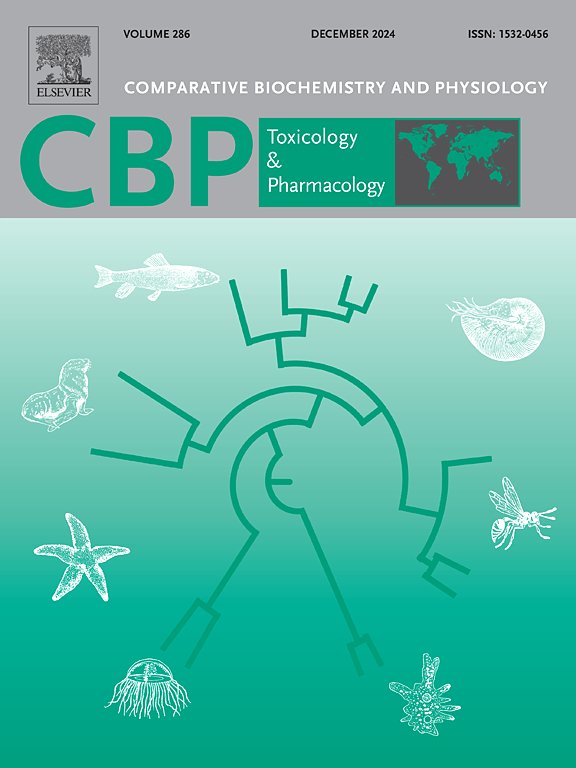Combined exposure effects: Multilevel impact analysis of cycloxaprid and microplastics on Penaeus vannamei
IF 3.9
3区 环境科学与生态学
Q2 BIOCHEMISTRY & MOLECULAR BIOLOGY
Comparative Biochemistry and Physiology C-toxicology & Pharmacology
Pub Date : 2024-12-06
DOI:10.1016/j.cbpc.2024.110107
引用次数: 0
Abstract
In real environments, multiple pollutants often coexist, so studying the impact of a single pollutant does not fully reflect the actual situation. Cycloxaprid, a new neonicotinoid pesticide, poses significant ecological risks due to its unique mechanism and widespread distribution in aquatic environments. Additionally, the ecological effects of microplastics, another common environmental pollutant, cannot be overlooked. This study explored the ecotoxicological effects of cycloxaprid and microplastics, both alone and in combination, on Penaeus vannamei over 28 days. The results revealed significant physiological impacts, with notable changes in the shrimp immune system and hepatopancreatic energy and lipid metabolism. Key findings include alterations in hemocyanin, nitric oxide, and phenol oxidase levels, along with disturbances in Na+/K+-, Ca2+-, and Mg2+-ATPase activities. Additionally, neural signaling disruptions were evidenced by fluctuations in acetylcholine, dopamine, and acetylcholinesterase levels. Transcriptomic analysis revealed the profound influence of these pollutants on gene expression and metabolic processes in the hepatopancreas and nervous system. This comprehensive assessment underlines the potential growth impacts on shrimp and underscores the ecological risks of cycloxaprid and microplastics, offering insights for future risk assessments and biomarker identification.

环磷酰胺和微塑料对凡纳滨对虾的多重暴露效应分析。
在实际环境中,多种污染物往往并存,因此研究单一污染物的影响并不能完全反映实际情况。环磷酰胺是一种新型的新烟碱类农药,其作用机制独特,在水生环境中分布广泛,具有重大的生态风险。此外,另一种常见的环境污染物微塑料的生态影响也不容忽视。本研究探讨了环xaprid和微塑料单独或联合使用对凡纳滨对虾(Penaeus vannamei) 28 天的生态毒理学效应。结果显示了显著的生理影响,虾的免疫系统、肝胰脏能量和脂质代谢发生了显著变化。主要发现包括血青素、一氧化氮和酚氧化酶水平的改变,以及Na+/K+-、Ca2+-和Mg2+- atp酶活性的紊乱。此外,乙酰胆碱、多巴胺和乙酰胆碱酯酶水平的波动证明了神经信号的中断。转录组学分析揭示了这些污染物对肝胰腺和神经系统基因表达和代谢过程的深远影响。这项综合评估强调了环xaprid和微塑料对虾的潜在生长影响,并强调了生态风险,为未来的风险评估和生物标志物鉴定提供了见解。
本文章由计算机程序翻译,如有差异,请以英文原文为准。
求助全文
约1分钟内获得全文
求助全文
来源期刊
CiteScore
7.50
自引率
5.10%
发文量
206
审稿时长
30 days
期刊介绍:
Part C: Toxicology and Pharmacology. This journal is concerned with chemical and drug action at different levels of organization, biotransformation of xenobiotics, mechanisms of toxicity, including reactive oxygen species and carcinogenesis, endocrine disruptors, natural products chemistry, and signal transduction with a molecular approach to these fields.

 求助内容:
求助内容: 应助结果提醒方式:
应助结果提醒方式:


